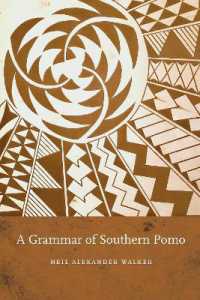- ホーム
- > 洋書
- > 英文書
- > History / World
Full Description
This volume examines how ideas of the nation influenced ordinary people, by focusing on their affective lives. Using a variety of sources, methods and cases, ranging from Spain during the age of Revolutions to post-World War II Poland, it demonstrates that emotions are integral to understanding the everyday pull of nationalism on ordinary people.
Contents
Introduction: emotions and everyday nationalism in modern European history
1. Feeling nationhood while telling lives: ego-documents, emotions and national character during the Age of Revolutions
2. So close and yet so far: degrees of emotional proximity in pauper letters to Dutch national power holders around 1800
3. 'Lou tresor dóu Felibrige': an Occitan dictionary and its emotional potential for readers
4. Learning to love: embodied practices of patriotism in the Belgian nineteenth-century classroom (and beyond)
5. Performing and remembering personal nationalism among workers in late Russian Poland
6. In search of the true Italy: emotional practices and the nation in Fiume 1919/1920
7. Bringing out the dead: mass funerals, cult of death and the emotional dimension of nationhood in Romanian interwar fascism
8. Feeling the fatherland: Finnish soldiers' lyrical attachments to the nation during the Second World War
9. Emotional communities and the reconstruction of emotional bonds to alien territories: the nationalization of the Polish 'Recovered Territories' after 1945
Conclusions: national(ized) emotions from below






